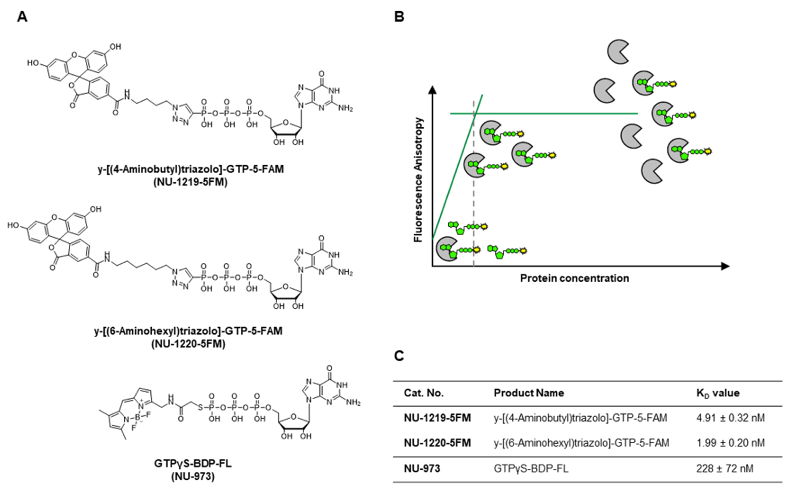Gαi1 proteins as part of heterotrimeric G proteins are molecular switches essential for GPCR mediated intracellular signaling by switching between an inactive GDP-bound and an active GTP-bound state[1]. Dysregulation of the switching mechanism is linked with various diseases, including different types of cancer, making Gαi1 proteins attractive therapeutic targets in drug research[2-4]. Several approaches have been described in the past using fluorescent GTP analogs to address the Gαi1 proteins, lacking both the accurate determination of the protein’s guanine nucleotide binding activity and fraction of active protein[5].
Pepanian et al. recently developed a fluorescence anisotropy (FA)-based method to determine the binding affinity at the GTP-binding site and quantify the Gαi1 protein activity[5]. Since commonly used MANT-and BODIPY-[6-9]based probes lack broad applicability for FA-based assays, a new generation of fluorescein (FAM) labeled GTP analogs was developed with beneficial properties for FA-assay including high quantum yields and relatively short fluorescence lifetimes of the excited state (3.8 ns)[5]. Two high-affinity probes y-[(4-Aminobutyl)triazolo]-GTP-5-FAM and y-[(6-Aminohexyl)triazolo]-GTP-5-FAM for Gαi1 (KD values in the one-digit nM range) have been identified that possess an improved hydrolytic stability and binding affinity compared to MANT GTPγS and BODIPY FL GTPγS[5].

Figure 1: 5-FAM labeled GTP analogs with improved stability and affinity for the Gαi1 protein compared to BODIPY FL GTPγS.
A) Chemical structures of y-[(4-Aminobutyl)triazolo]-GTP-5-FAM (NU-1219-5FM), y-[(6-Aminohexyl)triazolo]-GTP-5-FAM (NU-1220-5FM) and BODIPY FL GTPγS (NU-973).
B) Assay scheme for determination of binding affinity of the fluorescent GTP analogs via fluorescence anisotropy-based method. (Figure adapted from Pepanian et al.[5])
C) Dissociation constants (KD) of y-[(4-Aminobutyl)triazolo]-GTP-5-FAM (NU-1219-5FM), y-[(6-Aminohexyl)triazolo]-GTP-5-FAM (NU-1220-5FM) and BODIPY FL GTPγS (NU-973).on Gαi1 protein[5].
| Cat. No. | Product | Specifications |
|---|---|---|
| NU-1219-5FM | y-[(4-Aminobutyl)triazolo]-GTP-5-FAM | Purity: >/= 95 % (HPLC) Concentration: 1.0 mM - 1.1 mM pH: 7.5 ± 0.5 |
| NU-1220-5FM | y-[(6-Aminohexyl)triazolo]-GTP-5-FAM | Purity: >/= 95 % (HPLC) Concentration: 1.0 mM - 1.1 mM pH: 7.5 ± 0.5 |

Contact Dr. Lisa Goebel at nucleotides@jenabioscience.com with any questions you may have!
[1] Li et al. (2020) Heterotrimeric G Proteins as Therapeutic Targets in Drug Discovery. J. Med. Chem. 63(10):5013.
[2] Arang et al. (2020) G Protein-Coupled receptors and heterotrimeric G proteins as cancer drivers. FEBS Lett. 594(24):4201.
[3] O'Hayre et al. (2013) The emerging mutational landscape of G proteins and G-protein-coupled receptors in cancer. Nat. Rev. Cancer. 13(6):412.
[4] Nubbemeyer et al. (2021) Strategies towards Targeting Gαi/s Proteins: Scanning of Protein-Protein Interaction Sites To Overcome Inaccessibility. ChemMedChem. 16(11):1696.
[5] Pepanian et al. (2022) Fluorescence Anisotropy Assay with Guanine Nucleotides Provides Access to Functional Analysis of Gαi1 Proteins. Anal. Chem. 94(41):14410.
[6] Gille et al. (2003) 2'(3')-O-(N-methylanthraniloyl)-substituted GTP analogs: a novel class of potent competitive adenylyl cyclase inhibitors. J. Biol. Chem. 278(15):12672.
[7] McEwen et al. (2001) Fluorescent BODIPY-GTP analogs: real-time measurement of nucleotide binding to G proteins. Anal. Biochem. 291(1):109.
[8] Gill et al. (2003) Low-affinity interactions of BODIPY-FL-GTPgammaS and BODIPY-FL-GppNHp with G(i)- and G(s)-proteins. Naunyn Schmiedebergs Arch. Pharmacol. 368(3):210.
[9] Jameson et al. (2005) Real-time detection of basal and stimulated G protein GTPase activity using fluorescent GTP analogues. J. Biol. Chem. 280(9):7712.